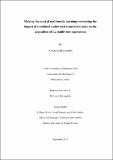| dc.contributor.advisor | Incalcaterra McLoughlin, Laura | |
| dc.contributor.author | Beltramello, Anastasia | |
| dc.date.accessioned | 2020-01-06T14:02:40Z | |
| dc.date.available | 2020-01-06T14:02:40Z | |
| dc.date.issued | 2019-09-16 | |
| dc.identifier.uri | http://hdl.handle.net/10379/15671 | |
| dc.description.abstract | The use of audiovisual material in the Italian L2 classes in the last decades has acquired an increasingly important role, especially since the communicative approach has identified spoken language as the main objective of teaching and learning practices. The establishment of such an approach resulted from a painstaking process of revision of traditional teaching tools and methods that shifted from giving great relevance to grammar and written words to putting orality to the centre of the debate. With communication being the main goal of L2 learning, didactic material created specifically for the school environment was no longer considered suitable, hence the introduction of multimedia products in the foreign language classroom. The European Survey on Language Competences reveals that Europeans still need to improve their knowledge of foreign languages. The reassessment of translation as a didactic tool and the continuous development of technological advances available to teachers and students resulted in the production of an ever growing number of studies suggesting that foreign language acquisition may be facilitated by using multimedia products combined with audiovisual translation techniques such as subtitling and revoicing. In particular, much of the current research is focussing on how subtitling and revoicing tasks can enhance language skills. The current doctoral project is placed in this line of research and it aims to shed light on the possible benefits of using a combination of AVT practices in the FL classroom on students’ vocabulary learning. By overcoming research in single-word acquisition, where words are often presented out of context, this study investigates the effects of the combination of dubbing and subtitling tasks on learners’ acquisition of multiword expressions.
A total of four studies were conducted in order to explore the potential of subtitling and the combination of subtitling and revoicing within the same module. All studies were integrated in the language curriculum of BA students of Italian as they were offered as full modules within the general language course. After extensive piloting, the main study focussed on an experimental investigation into the extent to which a combination of subtitling and dubbing tasks can benefit L2 learning as opposed to traditional unimodal translation.
The triangulation of qualitative and quantitative data revealed a steady trend towards improvement in vocabulary acquisition in both groups, with a slightly higher increase in the experimental group. | en_IE |
| dc.publisher | NUI Galway | |
| dc.rights | Attribution-NonCommercial-NoDerivs 3.0 Ireland | |
| dc.rights.uri | https://creativecommons.org/licenses/by-nc-nd/3.0/ie/ | |
| dc.subject | Audiovisual Translation | en_IE |
| dc.subject | Second Language Acquisition | en_IE |
| dc.subject | Subtitling | en_IE |
| dc.subject | Dubbing | en_IE |
| dc.subject | Italian | en_IE |
| dc.subject | Multiword expressions | en_IE |
| dc.subject | Languages, Literatures and Cultures | en_IE |
| dc.subject | Italian | en_IE |
| dc.title | Making the most of multimedia learning: evaluating the impact of combined audiovisual translation tasks on the acquisition of L2 multiword expressions | en_IE |
| dc.type | Thesis | en |
| dc.local.final | Yes | en_IE |
| nui.item.downloads | 905 | |


